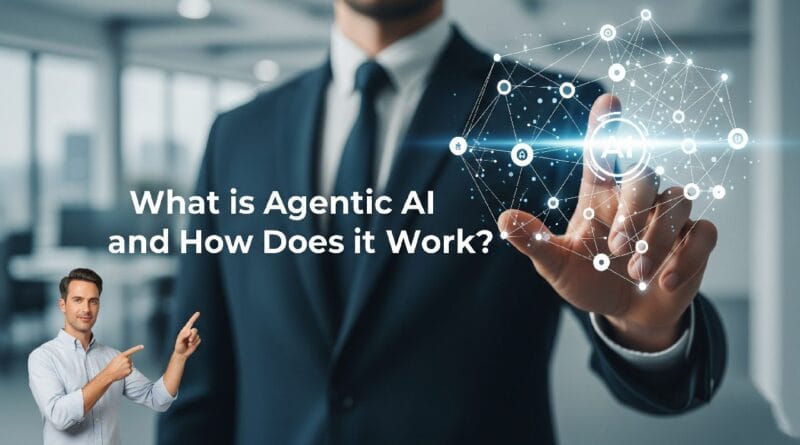What is Agentic AI? A Simple, No-BS Explanation & How it Works
My goal for today is to provide you with an extremely simple, no-BS explanation of Agentic AI. We’ll explore real-world Agentic AI systems, even delving into some code. Please stay with me until the end!
Let’s start with a real-life example from my own company. We have over 55 employees, and we want to build an HR assistant that can answer simple policy questions, such as “how many vacation days do they have per year?” or “what is the policy on sick leave?” All of this policy data is available in PDF files.
You could build a Retrieval Augmented Generation (RAG) chatbot that simply pulls information from these PDFs and answers these questions. Is this Agentic AI? The answer is no. Anthropic, in their document on building effective agents, categorizes AI applications into two groups: workflows and agents. This RAG-based chatbot is actually a workflow; it is not agentic.
Let’s advance this chatbot a bit. Imagine adding support for questions like, “How many leaves do I have left?” specifically for an individual employee, and even allowing them to apply for leaves directly through the system. This is important: it’s not just question and answer; you are taking actions. Here, you’d obviously have access to your policy data via PDFs, but on top of that, you’d integrate the Large Language Model (LLM) with an HR management system through its APIs. This would allow it to not only pull leave information for a given employee but also apply for a leave. The system would detect your login, identify you, and take the necessary action. Do we call this Agentic AI? Again, the answer is no. This is a tool-augmented chatbot.
We want to advance this further and give it a goal, such as “Prepare for Sara’s maternity leave.” This requires multi-step reasoning and multi-turn planning. Another example: “Onboard the new intern joining next Monday.” This also requires multi-step planning. Let’s call these “broader goals” – they aren’t simple tasks but complex ones that require multi-step reasoning followed by a plan.
For “onboarding a new intern,” an agentic system would first formulate a plan. This might involve:
- Scheduling a welcome meeting with the intern and sending the meeting invite via Outlook or your chosen calendar system.
- Creating the intern’s profile in the HR management system through integrated APIs. At every step, there will be some generation involved; for instance, if you schedule a meeting, you need to write a description, which the LLM can generate.
- Creating a ticket in the IT help desk to obtain Wi-Fi credentials, email, Slack access, etc., for that particular intern. Again, the LLM plays a role, along with integrations to tools like Slack, Outlook, and your Wi-Fi system.
- Ordering a laptop through an inventory management system or IT support desk.
This, folks, is Agentic AI! It requires multi-step reasoning and multi-step planning. In each of these steps, LLMs will be involved along with APIs, tools, knowledge, and memory.
If we describe a few key characteristics of an Agentic AI system:
- Goal-Oriented Planning: You are not giving a simple task like “tell me how many leaves I have left.” Instead, you are providing a complex task that requires both reasoning and multi-step planning.
- Multi-Step Reasoning: The system breaks down complex goals into a series of smaller, manageable steps.
- Autonomous Decision-Making: The system performs actions autonomously. It doesn’t just tell you what to do; it actually does the work, like sending an email or a meeting invite.
- Access to Tools: It integrates with various tools like Outlook, HR management systems, and others.
- Knowledge: It leverages diverse knowledge sources such as PDF files and databases.
- Memory: It maintains context during conversations, remembering past interactions.
Any AI system you build that possesses autonomy (the ability to make certain decisions and take actions on its own), coupled with multi-step complex reasoning and planning, is called Agentic AI.
In a very simple definition: Agentic AI is an AI system that can make decisions and take actions on its own to achieve a goal without being told exactly what to do at every step.
Here’s a table summarizing the capabilities of the three types of chatbots we discussed:
| Chatbot Type | Reactive (Q&A) | Tool Usage | Reasoning | Planning | Proactive |
| RAG-Based Chatbot | Yes | No | No | No | No |
| Tool-Augmented Chatbot | Yes | Yes | No | No | No |
| Agentic AI System | Yes | Yes | Yes | Yes | Yes |
There are many examples of Agentic AI systems:
- AI Coding: Tools like GitHub Copilot, Replit, or similar platforms can create a React Native app (e.g., a to-do list). They first figure out the necessary features, then engage in multi-step planning, write code, execute it, debug, fix issues, and iterate. This entire process exemplifies an Agentic AI system.
- Travel Assistant: Imagine a travel assistant where you can say, “Book a 7-day trip to London in May where the weather is sunny for at least 4 days and I have a budget of X.” An Agentic AI system would first prepare a plan (similar to how a deep-set reasoning model would), then execute that plan step-by-step with the help of integrated tools and APIs (e.g., AccuWeather API for weather, Expedia API for booking flights).
Here’s a small example of an Agentic AI system in action: writing an agent to assist an equity research analyst. Analysts typically write reports on companies. You can provide a goal like “Write a report on Nvidia” and give it access to tools like Yahoo Finance and DuckDuckGo search. Using a framework like agnos, when you run this code (available in the video description below), with a model like Gemini, it will analyze the goal, perform multi-step reasoning and planning, and then execute those steps. It will reason, “I need to gather this much information,” then plan steps like compiling a report, getting company info, analyst recommendations, and company news. It performs all of this step-by-step, generating a comprehensive report that includes key statistics, analyst recommendations, and recent news – it even figures out the structure on its own!
You don’t always have to write the code. You can use low-code or no-code tools like Zapier. Zapier demonstrates cloud integration with their Zapier NLA server. You connect various tools, and then you can ask, “What’s on my calendar?” It will access the calendar tool and provide the information. While these are simple tasks, you can design your NLA server to handle complex, multi-step reasoning processes using a reasoning model.
Another similar tool is N8N, which offers a drag-and-drop interface. For instance, you could set up a workflow where a “create user form submission” triggers an AI agent (e.g., using an Anthropic chat model) with a PostgreSQL chat memory and access to Jira, Microsoft Entra ID, etc. You can define these workflows to create RAG-based systems, tool-augmented systems, or even Agentic AI. For Agentic AI, the AI agent piece and the prompt you write are crucial for solving complex issues using a reasoning model like GPT-4o.
You might have these questions:
What is the difference between an AI agent and Agentic AI?
An Agentic AI system will have one or more AI agents. You can have multiple agents, but you need at least one AI agent with that complex, agentic reasoning behavior.
What is the difference between GenAI (Generative AI) and Agentic AI?
Generative AI is a part of Agentic AI. For example, a Google Gemini model might generate text, write an email, or summarize something – these are all generation capabilities. Generative AI is one of the components within your Agentic AI system. Generative AI focuses on creating new data (text, video, images), and it can be a subcomponent within your Agentic AI system.
If you want to see some real project examples with code for RAG and tool-augmented AI systems, I have two different videos that provide all the code (e.g., for a cold email generator and an HR leave management system).
I also suggest you read Anthropic’s “Building Effective Agents” guide. They outline various design patterns:
- Workflow-based design patterns: Here, an LLM acts as a router, directing questions to specific LLMs for technical support, sales, or other teams. Everything is hardwired through code. Another workflow example involves performing individual tasks using LLMs and then aggregating the results.
- Orchestrator-based workers: This is also a workflow.
- Agents: For agents, you’ll see a continuous loop of “action-feedback, action-feedback” – multi-step reasoning and multi-step planning.
Folks, I hope it’s now clear what exactly Agentic AI is. It’s just a jargon term, but the underlying idea is really simple.




